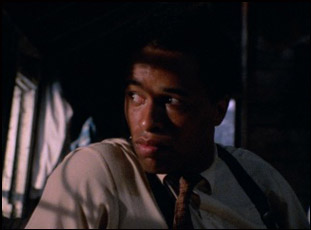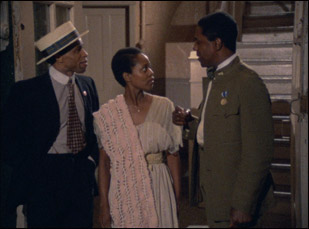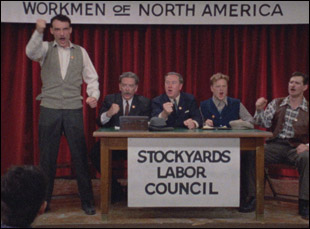Bill Duke can still remember when Chicago elected its first African-American mayor Harold Washington in April of 1983. The actor/director had been in town to shoot his first feature “The Killing Floor,” but it had been hard to concentrate when no matter where you were in the city, the streets were trembling just beneath.
“The night that people found out he had been elected, I can’t describe it,” recalls Duke, sharing one of the few good stories he left out of his beautiful memoir “My 40-Year Career on Screen and Behind the Camera”. “When I say people, I’m talking about hundreds and thousands of people running down the street, screaming and shouting, it was like Obama time. The streets went crazy – for days.”
As it happened, more than a few of Washington’s supporters had shown up to appear as extras in “The Killing Floor,” a drama recounting the push to unionize the Chicago stockyards in the late 1910s through the eyes of a young African-American organizer named Frank Custer (Damien Leake), which only gave further credence to Duke’s idea that despite all the period-appropriate set dressing and costumes, he was hardly making a film about the past.
Recently restored by the UCLA Film and Television Archive and made available for the first time digitally this week by Film Movement after being long out of circulation, the film feels more timely than ever as it observes how the colors of black and white are superseded by green as the workers who spend countless hours butchering and cleaning up after cow carcasses aren’t treated much better than the meat they process and a coalition forms between those who find that the promise of greater opportunity in Chicago, whether it’s African-Americans relocating from the South or immigrants from Poland and Ireland who may not get stopped by cops as frequently as their co-workers yet nonetheless are marginalized due to their tenuous citizenship status. Still, one faction of the workforce was more welcome than the other into the Amalgamated Meat Cutters and Butchers Workmen of North America and Custer’s disorientation from being recruited to fight for a common cause while feeling unequal is vividly depicted, showcasing Duke’s keen eye for telling provocative stories with visuals that cut through the complexities as well as for talent when there’s a slew of early featured roles for Alfre Woodard as Custer’s wife, Stephen McKinley Henderson as a local fixer, the late Dennis Farina as a stockyard manager and the late John Mahoney as a company middleman.
“The Killing Floor” was initially intended to be the first in a series of films about the labor movement in America spearheaded by Elsa Rassbach, but the single production was a struggle enough, with the producer taking seed money from her connections in public television and ultimately securing its release through American Playhouse, but building a budget from contributions made by union locals across the country. The road to release may have been difficult, but the result is uncompromised, likely part of why it remains so arresting even today and as the revival opens in virtual cinemas this week, Duke took a moment to reflect on recapturing this history so richly on a shoestring budget, the benefits of having such a strong cast and how the past year has brought a new appreciation of his films including his two collaborations with Laurence Fishbone “Deep Cover” and “Hoodlum.”

Its universal theme. It dealt with a family, it dealt with discrimination. It dealt with the labor union being created. It dealt with blacks and whites coming together for one purpose. These are all themes that I related to and when I read the script, it’s definitely something I wanted to do. I had worked on several things at PBS and Elsa [Rassbach] saw that and we talked. We had a similar vision of the film and we got together and the rest is history.
What was it like putting actual history on screen?
As a period piece, it’s always interesting. We had a location scout who understood cost of shooting, which is when you have a small budget, the biggest thing you have is the move — moving from one set to another — so if we were shooting in one neighborhood, he could find a house in that same neighborhood for the interiors and then if you’re going to drive around the block, you can get in a car and drive around the same block, so that helped us not move and be efficient in terms of the way we were shooting. And I wanted to be able to go and dress the street, but we just didn’t have the budget, so stock footage was very important for us and we used as much of it as we could afford. But a lot of it we created ourselves — the [cinematographer], the writers and myself, we came up with ideas that gave it an authenticity visually based on the budget we had.
Was it tricky to recreate an authentic stockyards?
At that time, there were still slaughterhouses in Chicago, but we had to redress things. When I was doing my scouting, I had never seen a cow slaughtered before and cut open and the guts dropping and then the skin coming off of it…you know, it made me want to be a vegetarian. [laughs]

We brought some names on, but there’s a lot of local talent in Chicago, so our auditions were great. We were very, very fortunate — the great Moses Gunn and Alfre Woodard and other people, that was a gift. The limited budget for a period piece is not always easy, but when we had great actors, after the second take, it was so good, you didn’t really need to do three or four or five or six takes. We didn’t. That’s what saved us the actors.
I was so taken with how the power dynamics were reflected in the blocking of scenes – did you have strong ideas about how to shoot this from the start?
Yes, at that time, I wanted to do almost like a documentary style and not having the camera too imposing, but really observing the phenom of what was occurring more than interfering with it and being too tricky with the camera. I didn’t want attention brought to the camera. I wanted attention brought to the story.
What was it like presiding over those big crowd scenes at the union protests and rallies?
[laughs] Challenging, but thank God I had a great staff and a great first AD working with the extras because handling that, no one person can do it. No matter what a director tells you, if [they] don’t have an infrastructure that can do that, you’re not going to survive. It’s too many people, but luckily we had great staff. And the history that was made at that time by workers, just the common man coming together, was wonderful. What’s fortunate and unfortunate is that some things have changed, but as you see today, some things have not, so the film still has relevance in terms of unemployment market, in terms of the unions, in terms of a lot of things, so it’s an ongoing challenge.
Yes, of course, and seeing people that thought they had opposite positions come together for one cause. That was exciting for me. They had different causes, they thought, but they were under one rule and when they realized that they could come together and march together and did things together, that was exciting and it’s relevant still for today.
This was the start of a wonderful directing career in features. Did you feel it was sustainable after making “The Killing Floor”?
Well, it’s not a kind business. You’re only as good as your last job, so when you finish something you’re thinking, “Mmmm, I hope this gets me my next job.” You’re not guaranteed that, but you always are grateful for being able to work and this led to other opportunities, let’s put it that way.
With the revival of this and the retrospective at the Metrograph and the recent celebration of “Deep Cover,” has it been nice to see your work appreciated today?
It’s been wonderful. It’s my legacy, so to have people celebrate my work and appreciate it has been a blessing to me on so many levels, I cannot tell you. It’s been a very positive thing and I’m grateful for that.
“The Killing Floor” opens on June 19th in virtual cinemas with proceeds split with your favorite local arthouse. A full list of participating theaters is here. Bill Duke will be appearing for a Q & A following a virtual screening of the film on June 21st at 5 pm PST through the American Cinematheque in Los Angeles, which you can register for here, and his memoir is available here.




